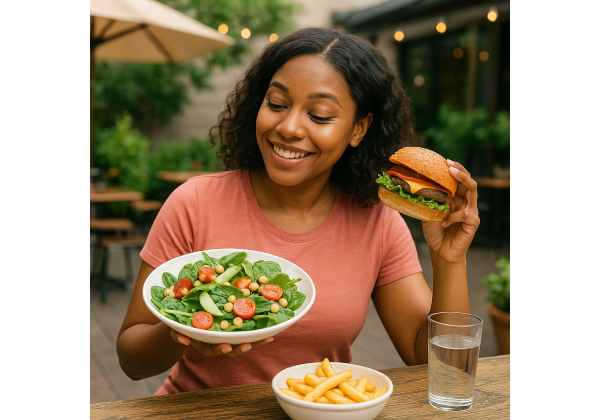
Weekends do not wreck progress because food is “bad.” They slip because structure disappears. The solution is not willpower; it is a light routine that survives parties, errands, and sleep-ins. This guide gives you a simple weekend plan—protein-anchored meals, social strategies that still feel fun, and a Monday reset that erases guilt. If you want the bigger picture of habits that make weight loss easier all week, see our brief overview of habit, sleep and stress basics.
Table of Contents
- Weekend diet basics
- Plan your weekend in 15 minutes
- Weekend meals and movement
- Restaurants, drinks and parties
- Handle cravings and boredom
- Lapses, relapses and reset
- Tracking weekend results
- Frequently asked questions
Weekend diet basics
Why weekends feel harder. Weekdays run on autopilot—alarms, commutes, packed lunches. Friday night arrives and the schedule dissolves. Sleep shifts later. Meals drift. Alcohol shows up. Social food is everywhere. None of this is “failure.” It is just a different environment. Your plan needs to be portable enough to fit it.
Your weekend operating system (three guardrails).
- Protein at the first meal, every day. Aim for 25–35 g at breakfast or your first eating occasion. That one move cuts evening grazing by stabilizing hunger.
- One-plate rule at main meals. Fill ½ plate vegetables, ¼ plate protein, ¼ plate starch. Flavor with a spoon of oils/sauces, not a pour. At restaurants, translate the same proportions to what lands on your single plate.
- Ten-minute walk after two largest meals. Post-meal movement steadies appetite and improves energy. It also creates a “hard stop” between eating and the rest of your plans.
The weekend math that actually matters. A calorie deficit works by averages, not perfect days. If you are consistent Monday–Thursday and simply reasonable Friday–Sunday, your weekly trend still moves. Think in weeks, not days.
Where choice architecture wins.
- Environment first: Put “green-light” snacks at eye level; stash sweets in opaque bins.
- Defaults ready: Two easy breakfasts, two easy lunches, a “company meal” you can serve guests that still fits your plate method.
- Rituals replace rules: A five-minute pre-event plan, water before alcohol, walk before dessert.
What not to do. Do not skip breakfast to “save calories” if it triggers night raids. Do not punish yourself with long fasts on Monday. Do not label events as “good” or “bad.” Label them planned or unplanned, then use the reset steps below.
If you want a quick refresher on pacing, safe rates of change, and how to set up a sustainable deficit, review our guide to safe weight loss steps and plug these weekend tactics into that framework.
Plan your weekend in 15 minutes
You do not need a spreadsheet to protect progress. You need a Friday check-in that makes the rest of the weekend easier. Give yourself 15 quiet minutes—calendar open, text threads checked—and make three small decisions.
1) Pick your “anchor meals.”
Choose two meals you will nail no matter what. Good anchors:
- Protein-forward breakfast (yogurt bowl; eggs and veg; tofu scramble with toast).
- Plate-method dinner at home or the simplest restaurant you frequent (bowl, grill, salad bar).
Anchors shrink decisions for ⅔ of your day. You can be flexible with the rest.
2) Mark your “joy windows.”
You are allowed joy. In fact, planned joy stops the “might as well” spiral. Pick one per day: shared dessert, favorite pastry, a cocktail, pizza night. Name it, enjoy it slowly, and stop when satisfied. Unplanned joy still happens; planning one removes scarcity.
3) Decide movement by context, not motivation.
Write down when you will pair ten-minute walks to meals and where (around the block, to the park, laps at the mall if weather is bad). If you enjoy training, schedule one 20–30 minute strength session. But if weekends are chaotic, walks are the backbone.
Fast grocery list (to handle gaps).
If you arrive home late or plans change, two minutes at a corner shop can rescue the evening. Buy: skyr or Greek yogurt; berries; bagged salad; rotisserie chicken or tofu; whole-grain wraps; frozen veg. That gives you breakfast anchors and a one-plate dinner.
Micro-plans for common weekend trips.
- Kids’ sports morning: Protein shake + banana before you leave; snack box (nuts, fruit, jerky); simple lunch out (bowl or wrap) after.
- Day hike or market day: Protein-packed breakfast; packed sandwiches; water bottle in hand; small treat at the end.
- Home project day: Slow cooker proteins (chicken thighs or beans) and washed salad ready by noon; postpone the “reward food” until dinner to avoid all-day nibbling.
Accountability that takes two minutes.
Send a friend a Friday text with your two anchors, two walks, and two joy windows. Ask them to reply with theirs. Quick check-ins keep you honest without adding pressure. If you want a simple framework to make accountability stick, borrow ideas from our guide to weekly check-ins.
What to track in the check-in.
- Anchors planned (Y/N)
- Walks scheduled (Y/N)
- Joy windows named (Y/N)
- Grocery “rescue kit” stocked (Y/N)
This is not about perfection. It is about removing friction from the 3–4 moments that usually decide your weekend.
Weekend meals and movement
Weekends reward templates, not willpower. Build yours with protein + produce first, then add the starch you truly want. Keep movement tied to meals rather than hunting for time you will never “find.”
Breakfast templates (25–35 g protein).
- Yogurt bowl: Greek or soy yogurt, berries, ¼ cup high-fiber cereal or oats, a sprinkle of chia.
- Egg and veg plate: 2–3 eggs or tofu scramble with peppers, spinach, and mushrooms; one slice of whole-grain toast.
- Protein oats: Oats cooked with milk or soy milk; stir in a scoop of protein; sliced banana and cinnamon.
- On-the-go: Protein shake + apple; cottage cheese cup + grapes.
Lunch that travels.
- Wraps: Whole-grain wrap packed with chicken or tofu, hummus, and a mountain of vegetables; fruit on the side.
- Bowls: ½ plate vegetables, ¼ protein, ¼ starch (rice, potatoes, beans); olive-lemon drizzle.
- Soup and salad combo: Lentil or chicken soup plus big salad; whole-grain roll fits the starch quarter.
Dinner that pleases a crowd.
- Sheet-pan dinners: Salmon or tempeh, mixed veg, small tray of potatoes; measure oil with a spoon.
- Stir-fry night: Lean beef or edamame, frozen veg, small scoop of rice; sauce on the side.
- Taco night: Protein (fish, chicken, black beans), pile of veg, small stack of tortillas; guac as a topping, not a layer.
Structured snacks (10–20 g protein).
Cottage cheese and pineapple, edamame and an orange, roasted chickpeas, cheese stick and high-fiber crackers, protein bar with ≥5 g fiber.
Planned sweet finish.
End dinner with something small and satisfying (yogurt and berries; protein pudding; baked apple with cinnamon). This closes the kitchen and avoids “continuous dessert.”
Movement made automatic.
- After-meal loops (non-negotiable): Ten minutes after lunch and dinner—around the block, with the dog, or up and down your building’s stairs.
- Micro-sessions: During laundry cycles or halftime, do 3 rounds of 10 squats, 10 push-ups (hands on countertop if needed), 30-second plank.
- Errand rule: Park far once per trip and take the long aisle.
Short, certain movement beats the perfect workout that never happens. If you like a clear nudge, use our simple guide to post-meal walks to lock the habit in place.
Restaurants, drinks and parties
Social food should feel like living, not like losing control. Use structure first, indulgence second—a quick plan before you sit down, a smart order, and boundaries you can keep even when the table gets lively.
Before you go (2 minutes).
- Eat a protein mini-meal if you will arrive starving (e.g., yogurt cup or shake + fruit).
- Pick your joy (one: shared dessert, cocktail, fries). Write it in your notes if that helps.
- Choose a plate strategy: “I will eat to comfortable fullness, not stuffed,” and “I will leave bites if portions are huge.”
What to order.
- Start with vegetables (salad or broth-based soup).
- Protein-forward main: grilled, roasted, braised, baked, or stir-fried; ask for sauces on the side.
- Own the starch: potato, rice, pasta, bread—make it ¼ plate. Share sides when portions are massive.
- Eat the joy you chose and savor it slowly. If dessert is your pick, share and take the middle bites; they are the best anyway.
Alcohol without unraveling the evening.
- Set a cap (e.g., one drink). Alternate with a full glass of water.
- Order alcohol with the main course, not on an empty stomach.
- If you have multiple events this weekend, spread drinks across nights rather than stacking them into one.
Buffets and potlucks.
- Lap the table first; decide what is worth it.
- Build the plate method once. Then add one small dessert or special item you truly want.
- Sit away from the food, keep water nearby, and join conversations that are not near the snack table.
End the night well.
- A ten-minute walk after leaving the restaurant smooths blood sugar and tells your brain, “the meal is done.”
- Have a planned sweet finish at home if you skipped dessert out—yogurt and berries works.
If drinks are your recurring derailleur, set yourself up with concrete choices using our focused guide to lower-calorie alcohol habits. Small changes there protect a lot of weekend progress.
Handle cravings and boredom
Weekends often bring unscheduled time, which quickly turns into pantry tours. Distinguish cravings from true hunger, give both a simple response, and design your environment so the path of least resistance is the one you want.
First, name it.
- Hunger: builds gradually, many foods sound fine, stomach sensations.
- Craving: sudden, specific (“I want chips”), often triggered by emotions, screens, or seeing food.
If it is hunger, feed it well.
- Structured snack: protein + fiber (e.g., cottage cheese + fruit; edamame + orange; yogurt + high-fiber cereal).
- Drink water or tea and sit for five minutes. Real hunger calms when fed; cravings escalate when teased.
If it is a craving, run the 20-minute protocol.
- Delay with a timer and make tea or sparkling water.
- Disrupt with a short task: quick walk, shower, two chores, or a call to a friend.
- Decide at 20 minutes: still want it? Have a single-serve portion, eat it slowly, and move on. No guilt.
Boredom-proof your kitchen.
- Visibility: put sweets away and fruit in plain sight.
- Portions: break chips and nuts into single serves; avoid “family size” bags at home.
- Friction: keep ice cream as single sticks or sandwiches, not tubs.
Screen cues and late nights.
- Set a caffeine cutoff 8–10 hours before bedtime so late cravings do not spike.
- Dim lights the last hour and charge your phone out of reach; both help you avoid “scroll-and-snack.”
- If evenings are your trouble spot, strengthen breakfast (add 10–15 g protein) and make lunch a proper plate.
For a deeper playbook on turning “I am bored” into “I am done,” bookmark our step-by-step guide on how to stop boredom eating. If your pattern is more about late-night snacking after dinner, we also have a dedicated strategy set for that.
Lapses, relapses and reset
Perfection is not the goal. Recovery speed is. A lapse is a one-off detour; a relapse is days or weeks of drift. Treat the former as data and the latter as a signal to shrink your plan until it is doable again.
After a lapse (same day).
- Call it: “That was more than I planned.” No judgment.
- Run the reset: next meal follows the plate method; take a ten-minute walk; drink a full glass of water.
- Move on: no compensation fasting, no “I will be perfect tomorrow.” You are already back on plan.
If the entire weekend drifted.
- Write a two-line post-mortem: What triggered it? Which two habits would have helped most?
- Pick one leverage point for the next weekend (e.g., protein at first meal; one-plate dinners; walk after meals).
- Rebuild momentum with small wins Monday–Wednesday: breakfast anchors, walks, early caffeine cutoff.
Prevent relapses with constraints you can keep.
- Shrinking strategy: When life is hectic, do less but keep the rhythm—anchors + walks.
- Environment: Do not bring family-size temptations home. If they must be there, store them out of reach and out of sight.
- Accountability: Weekly check-ins and a Friday plan reduce “decision fatigue” that fuels relapses.
If you want a clean framework for bouncing back without drama, see our quick protocol on lapses versus relapses—it is built for real life, not ideal weeks.
Tracking weekend results
Weekends can create noisy data—more salt, more social meals, different sleep. Do not let one Monday weigh-in define your week. Measure process and trend so a fun Saturday does not masquerade as “lost progress.”
Process metrics (daily boxes to tick).
- Protein at first meal (Y/N)
- Two one-plate meals (0/1/2)
- Two ten-minute walks (0/1/2)
- Caffeine cutoff respected (Y/N)
- Joy window planned (Y/N)
Outcome metrics (weekly).
- Weight trend: Take 2–4 morning weigh-ins per week, average them, and compare week to week.
- Waist measurement: At the navel every two weeks.
- Energy and appetite notes: “Even,” “snacky,” or “dragging.”
Course-correcting without overreacting.
- If your weight trend stalls for 3–4 weeks and you want further loss, pull a single lever for 7 days:
- Add 10–15 g protein at breakfast.
- Tighten dinner starch from a heaping ¼ plate to a level ¼.
- Remove unstructured bites—only structured snacks.
- Add one extra ten-minute walk most days.
Mindset for long-term success.
- Judge progress by averages, not single days.
- Keep two breakfast and two lunch defaults ready to deploy every weekend.
- When you fall off, restart at the next meal. The fastest reset wins.
Frequently asked questions
How do I stay on track at a friend’s dinner without being “that person”?
Eat a small protein snack before you go, start with vegetables, choose a protein-forward main, and decide on one joy—dessert or a drink. Keep portions to a single plate and take a ten-minute walk after. You will enjoy the meal and still finish the night in bounds.
Is it better to skip breakfast on weekends if I overeat at night?
Only if skipping actually reduces total intake and keeps you steady. For many people, a 25–35 g protein breakfast prevents afternoon and evening overeating. Test for two weekends: compare energy, cravings, and nighttime control, then choose the pattern that works.
How can I drink alcohol and still make progress?
Decide your cap before you arrive (e.g., one drink), alternate with water, and order alcohol with the main course. Choose lighter options if you prefer, but pacing and boundaries matter more than the exact drink. Keep your one-plate dinner and planned sweet finish.
What should I do after a big binge on Saturday?
Name it, do the reset trifecta (plate-method next meal, ten-minute walk, full glass of water), and go to bed on time. Do not starve on Sunday; eat your anchors and walk. On Monday, resume normal habits. Faster recovery beats compensation.
Are cheat meals helpful on weekends?
Label it planned joy rather than “cheat.” Enjoy one chosen item slowly within a normal plate-method meal. This avoids the “I blew it, might as well” spiral and keeps your weekly average aligned with your goal.
How much should I exercise on weekends?
Tie movement to meals: two ten-minute walks per day is the most reliable anchor for appetite and energy. Add a 20–30 minute strength session if you enjoy it, but do not skip the walks waiting for a perfect workout window.
References
- Positive impact of a 10-min walk immediately after glucose intake on postprandial glucose levels 2025 (RCT)
- After Dinner Rest a While, After Supper Walk a Mile? A Systematic Review with Meta-analysis on the Acute Postprandial Glycemic Response to Exercise Before and After Meal Ingestion in Healthy Subjects and Patients with Impaired Glucose Tolerance 2023 (Systematic Review & Meta-analysis)
- Diabetes Meal Planning 2024 (Guideline)
- The Acute Effects of Breakfast Drinks with Varying Protein and Energy Contents on Appetite and Free-Living Energy Intake in UK Older Adults 2022 (RCT)
- Effect of Protein-Rich Breakfast on Subsequent Energy Intake and Subjective Appetite in Children and Adolescents: Systematic Review and Meta–Analysis of Randomized Controlled Trials 2021 (Systematic Review & Meta-analysis)
Disclaimer
This article provides general education and is not a substitute for personalized medical advice, diagnosis, or treatment. If you have diabetes, kidney disease, disordered eating, or other medical conditions, talk with your clinician or a registered dietitian about a weekend plan tailored to your needs and medications.
If this guide helped, please share it with a friend who struggles most on Fridays and Saturdays—and follow us on Facebook, X, or whichever network you use for steady, practical strategies on meals, movement, and mindset that make weekends work.










